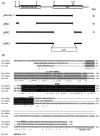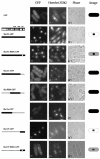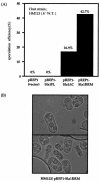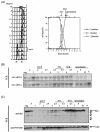Sla1, a Schizosaccharomyces pombe homolog of the human La protein, induces ectopic meiosis when its C terminus is truncated
- PMID: 14665462
- PMCID: PMC326650
- DOI: 10.1128/EC.2.6.1274-1287.2003
Sla1, a Schizosaccharomyces pombe homolog of the human La protein, induces ectopic meiosis when its C terminus is truncated
Abstract
Sla1 is a Schizosaccharomyces pombe homolog of the human La protein. La proteins are known to be RNA-binding proteins that bear conserved RNA recognition motifs (La and RRMs), but their biological functions still have not been fully resolved. In this study, we show that the S. pombe La homolog (Sla1) is involved in regulating sexual development. Sla1 truncated in the C terminus (Sla1DeltaC) induced ectopic sporulation in the ras1Delta strain and several other sporulation-deficient mutants. The C terminus contains a nuclear localization signal. While full-length Sla1 localizes in the nucleus, Sla1DeltaC is found throughout the cell, suggesting the cytoplasmic localization of Sla1DeltaC is involved in its sporulation-inducing activity. Further deletion analysis of Sla1 indicated that a small region (35 amino acids) that includes a portion of RRM2 is sufficient to induce sporulation. The La motif (RRM1) is not involved in this activity. Strikingly, Sla1DeltaC induced haploid meiosis in a heterothallic strain, similar to the pat1-114 or mei2-SATA mutation. Sla1DeltaC induced sporulation in a mei3 disruptant but not in a mei2 disruptant, indicating that Sla1DeltaC requires Mei2 to induce haploid meiosis. Deletion of the chromosomal sla1 gene lowered the temperature sensitivity of the pat1-114 mutant. Two-hybrid analysis indicated that Pat1 interacts with Sla1DeltaC but not full-length Sla1. Thus, Sla1DeltaC may block Pat1 activity. This block would remove the inhibition on Mei2, which would then drive the cell into haploid meiosis. Finally, Sla1 was degraded prior to the start of meiosis when we monitored Sla1 in cells in which meiosis was synchronously induced. The ability of truncated Sla1 to induce ectopic meiosis represents a very novel function that has hitherto not been suspected for the La family of proteins.
Figures








Similar articles
-
Truncated Sla1 induces haploid meiosis through the Pat1-Mei2 system in fission yeast.Biosci Biotechnol Biochem. 2004 Jan;68(1):266-70. doi: 10.1271/bbb.68.266. Biosci Biotechnol Biochem. 2004. PMID: 14745200
-
[Ash2, a subunit of histone H3K4 methyltransferase complex, is involved in the sporulation in Schizosaccharomyces pombe].Yi Chuan. 2014 Sep;36(9):943-51. doi: 10.3724/SP.J.1005.2014.0943. Yi Chuan. 2014. PMID: 25252312 Chinese.
-
Characterization of functional regions in the Schizosaccharomyces pombe mei3 developmental activator.Genetics. 1998 Nov;150(3):1007-18. doi: 10.1093/genetics/150.3.1007. Genetics. 1998. PMID: 9799254 Free PMC article.
-
Analysis of Schizosaccharomyces pombe Meiosis.Cold Spring Harb Protoc. 2017 Sep 1;2017(9):pdb.top079855. doi: 10.1101/pdb.top079855. Cold Spring Harb Protoc. 2017. PMID: 28733417 Review.
-
Regulation of meiosis in fission yeast.Cell Struct Funct. 1996 Oct;21(5):431-6. doi: 10.1247/csf.21.431. Cell Struct Funct. 1996. PMID: 9118252 Review.
Cited by
-
A dominant negative 14-3-3 mutant in Schizosaccharomyces pombe distinguishes the binding proteins involved in sexual differentiation and check point.PLoS One. 2023 Oct 3;18(10):e0291524. doi: 10.1371/journal.pone.0291524. eCollection 2023. PLoS One. 2023. PMID: 37788281 Free PMC article.
-
Multistep regulation of protein kinase A in its localization, phosphorylation and binding with a regulatory subunit in fission yeast.Curr Genet. 2011 Oct;57(5):353-65. doi: 10.1007/s00294-011-0354-2. Epub 2011 Aug 31. Curr Genet. 2011. PMID: 21879336
-
zds1, a novel gene encoding an ortholog of Zds1 and Zds2, controls sexual differentiation, cell wall integrity and cell morphology in fission yeast.Genetics. 2006 Feb;172(2):811-25. doi: 10.1534/genetics.105.050906. Epub 2005 Dec 1. Genetics. 2006. PMID: 16322512 Free PMC article.
-
A novel gene, msa1, inhibits sexual differentiation in Schizosaccharomyces pombe.Genetics. 2004 May;167(1):77-91. doi: 10.1534/genetics.167.1.77. Genetics. 2004. PMID: 15166138 Free PMC article.
-
Moc3, a novel Zn finger type protein involved in sexual development, ascus formation, and stress response of Schizosaccharomyces pombe.Curr Genet. 2005 Dec;48(6):345-55. doi: 10.1007/s00294-005-0028-z. Epub 2005 Nov 5. Curr Genet. 2005. PMID: 16273369
References
-
- Alfa, C., P. Fantes, J. Hyams, M. McLeod, and E. Warbrick. 1993. Experiments with fission yeast: a laboratory course manual. Cold Spring Harbor Laboratory Press, Cold Spring Harbor, N.Y.
-
- Ayukawa, K., S. Taniguchi, J. Masumoto, S. Hashimoto, H. Sarvotham, A. Hara, T. Aoyama, and J. Sagara. 2000. La autoantigen is cleaved in the COOH terminus and loses the nuclear localization signal during apoptosis. J. Biol. Chem. 275:34465-34470. - PubMed
-
- Bachmann, M., D. Falke, and W. E. Muller. 1990. Is La protein involved in autoimmunization and inflammatory events during disease? Characterization of La protein as an unwinding enzyme. Mol. Biol. Rep. 14:49-50. - PubMed
-
- Beach, D., L. Rodgers, and J. Gould. 1985. ran1+ controls the transition from mitotic division to meiosis in fission yeast. Curr. Genet. 10:297-311. - PubMed
-
- Burke, D., D. Dawson, and T. Stearns. 2000. Methods in yeast genetics; a Cold Spring Harbor Laboratory course manual. Cold Spring Harbor Laboratory Press, Cold Spring Harbor, N.Y.
Publication types
MeSH terms
Substances
LinkOut - more resources
Full Text Sources
Molecular Biology Databases
Miscellaneous

